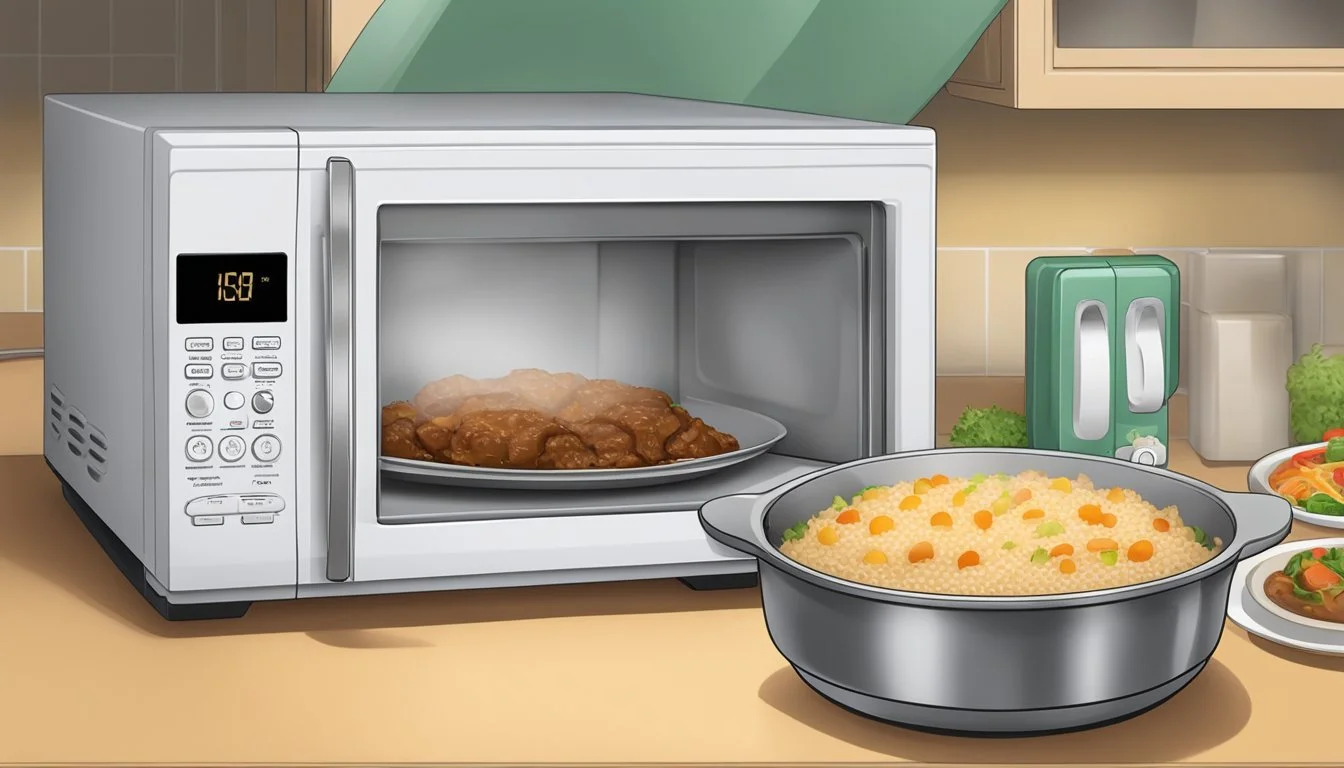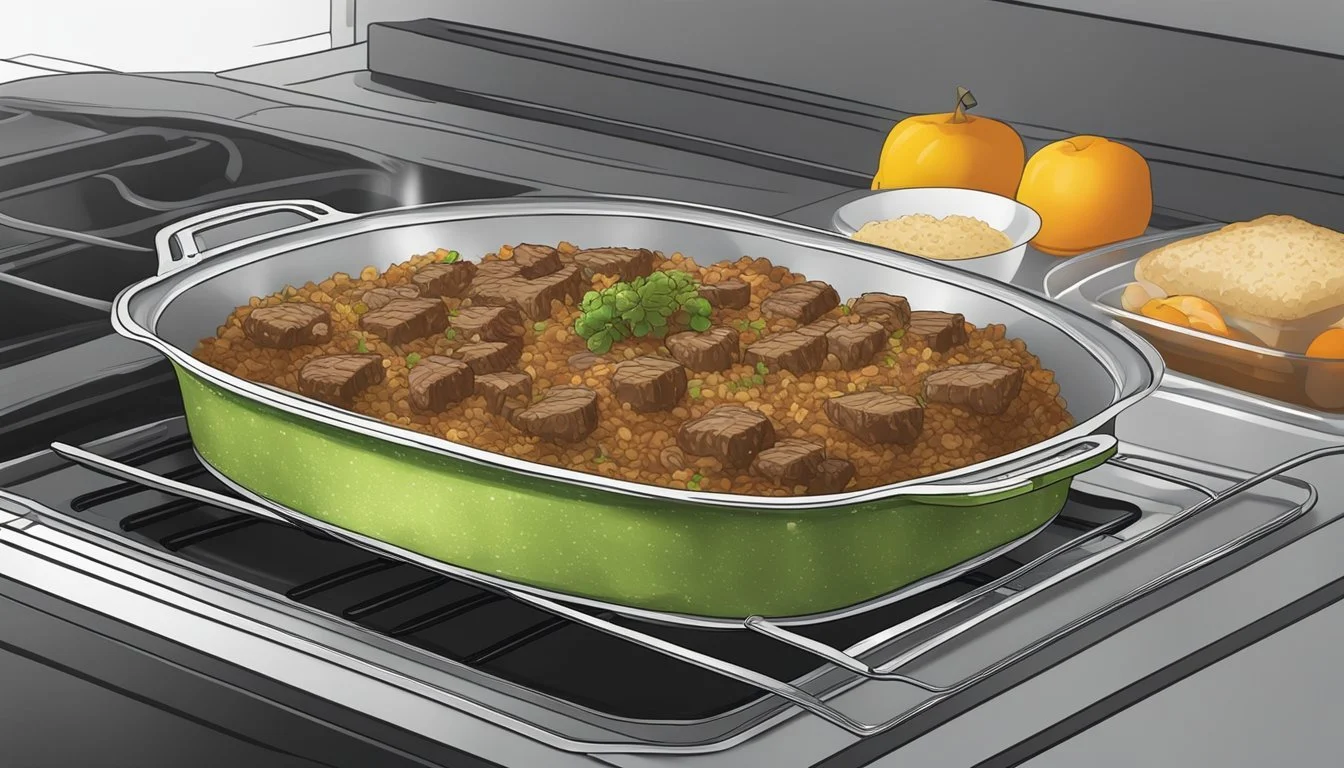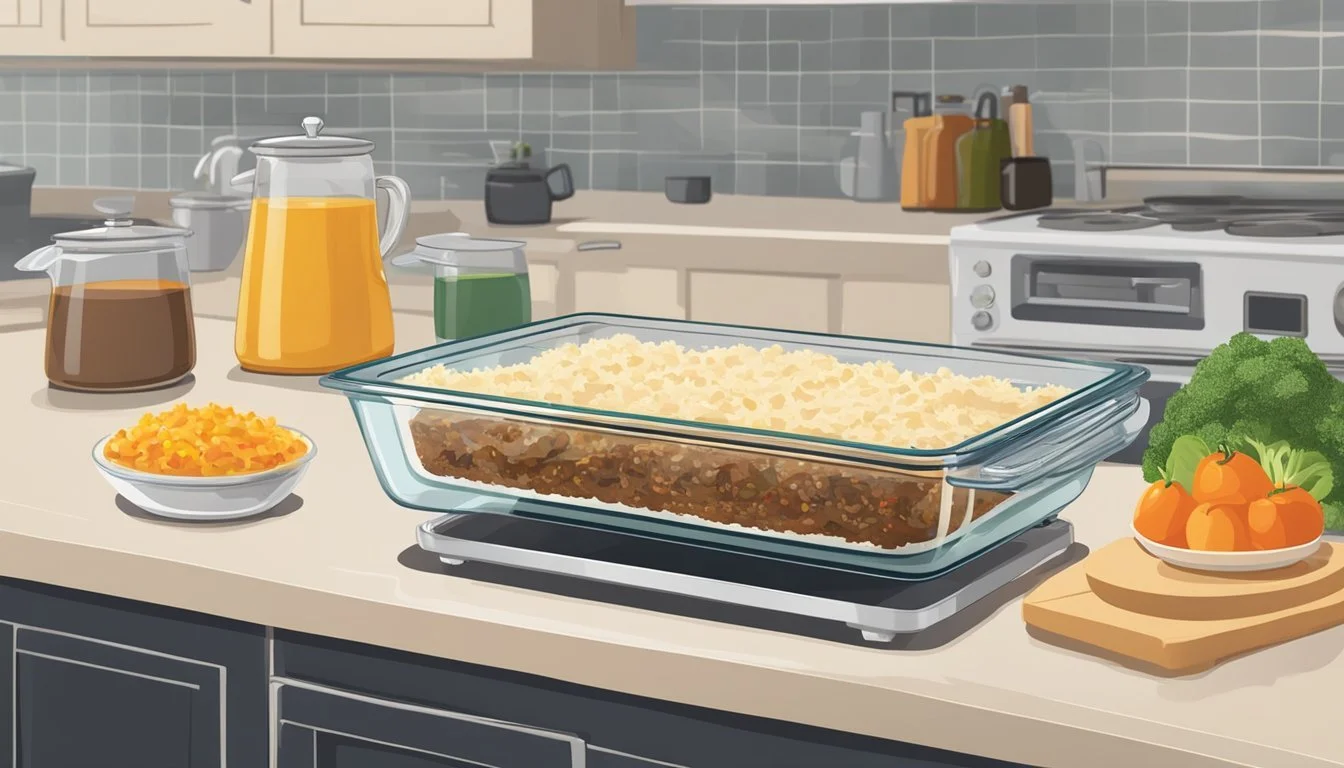How to Reheat Beef and Rice Casserole
Expert Tips for Perfect Leftovers
Reheating a beef and rice casserole without compromising its flavor can be a challenge, but it's entirely possible with a few simple steps. When it comes to leftovers from a beloved family meal, the goal is to ensure the casserole remains moist and delicious. The key to reheating beef and rice casserole is to cover it with foil and bake it at 350 degrees Fahrenheit until it's warmed through.
To start, allow the casserole to come to room temperature for about 30-60 minutes. This step helps it heat more evenly and reduces the chances of it drying out. Placing a moist paper towel over the top before covering with foil helps retain moisture, preventing dryness.
For the best results, monitor the internal temperature, aiming for it to reach 165 degrees Fahrenheit. This guarantees that the casserole is safe to eat while keeping it as juicy and flavorful as when it was first served. The simple steps ensure that your beef and rice casserole remains a family favorite, even as leftovers.
Overview of Reheating Casseroles
Reheating casseroles involves maintaining their texture and moisture while ensuring food safety. The choice of reheating method impacts the final dish quality.
Importance of Proper Reheating
Properly reheating casseroles is essential to maintain food quality and ensure safety. When done correctly, textures remain intact, and moisture levels are preserved.
The goal is to achieve an internal temperature of at least 165°F (74°C) to kill any harmful bacteria.
Not meeting this temperature can lead to health risks. Uneven reheating in methods like microwaves can sometimes leave cold spots, which must be avoided.
Choosing the Right Reheating Method
The oven is an excellent choice for reheating casseroles. It provides even heating and can help retain the dish's original texture and moisture content.
To reheat in the oven, preheat to 350°F (175°C), cover the casserole with foil to prevent drying, and bake until it reaches the necessary internal temperature.
Microwaves can be used for convenience. While quicker, they may dry out the casserole or heat unevenly. Cutting the casserole into smaller portions can help distribute heat more evenly.
Preparation for Reheating
To achieve optimal results when reheating a beef and rice casserole, it's crucial to follow specific steps to ensure even heating and maintain moisture. Proper preparation can make a significant difference in the texture and taste of your dish.
Bringing Casserole to Room Temperature
Start by taking the leftover casserole out of the refrigerator. It is recommended to let the casserole sit at room temperature for 30-60 minutes before reheating. This step helps in reducing the reheating time, ensuring even heat distribution, and avoiding thermal shock to your dish.
If the casserole was frozen, allow it to thaw adequately. A safe method is to transfer the casserole from the freezer to the refrigerator the night before. This gradual thawing process keeps the casserole within safe temperature zones, reducing the risk of bacteria growth.
Prepping the Casserole for Heat
Before reheating, check if the casserole needs any additional moisture. If it appears dry, drizzle approximately 2 tablespoons of water, broth, or oil around the edges to keep it from drying out. Cover the dish with aluminum foil to retain moisture and prevent the top from burning.
For smaller portions or if using a microwave, place a damp paper towel over the top and use a microwave-safe container. In an oven, the foil acts as a barrier against drying out. Ensure your bakeware is oven-safe, and preheat the oven to 350°F. A properly preheated oven aids in even heating, giving you the best possible results.
Reheating in the Oven
Reheating a beef and rice casserole in the oven ensures even heating and preserves its delicious flavors. Follow these steps for best results while keeping an eye on moisture and texture.
Steps to Reheat a Casserole in the Oven
Preheat the Oven: Set your oven temperature to 350 degrees Fahrenheit.
Prepare the Casserole: Place the beef and rice casserole in an oven-safe dish. Cover it with aluminum foil to prevent the dish from drying out.
Add Moisture: To ensure the casserole stays moist, add a small amount of water or broth if it appears dry. Optionally, you can place a moist paper towel over the top before covering it with foil.
Bake: Place the dish in the preheated oven and bake for 20-30 minutes. The cooking time may vary based on the size and depth of the dish.
Check Temperature: Use an instant-read thermometer to ensure the internal temperature reaches at least 165 degrees Fahrenheit.
Ensuring Even Heating
Bring to Room Temperature: Remove the casserole from the refrigerator 30-60 minutes before reheating. This step reduces reheating time and promotes even cooking.
Covering: Use aluminum foil to cover the casserole. This helps retain heat while preventing the top from drying out or burning.
Positioning: Place the dish in the center of the oven. Aim for an even distribution of heat to ensure all parts of the casserole are reheated properly.
Observation: Halfway through reheating, check the casserole. Stir if necessary to ensure the heat distributes evenly.
Crispy Topping: If the casserole has a topping that should be crispy, uncover the dish for the last 5-10 minutes of baking.
By following these practices, you will achieve a hot, moist beef and rice casserole with a perfectly warmed interior.
Reheating on the Stove
Reheating a beef and rice casserole on the stove can help preserve its texture and moisture. This method is ideal for achieving even heating without drying out the dish.
Preparing Skillet for Reheating
Begin by selecting a large, non-stick skillet to avoid sticking. If available, a skillet with a lid can help retain moisture during the reheating process.
Transfer the casserole to the skillet, breaking up any large chunks for even heating. Add a small amount of water or broth (about 2-3 tablespoons) to the skillet to generate steam and keep the rice from drying out.
Cover the skillet with a lid, and place it on the stove over medium heat. The lid helps to trap steam, reheating the casserole gently and evenly. If the skillet does not have a lid, using aluminum foil as a cover works well.
Monitoring the Heat
While reheating, it is crucial to monitor the heat. Keep the stove at medium heat to prevent the casserole from burning or sticking to the skillet. Stir the casserole every few minutes to ensure that the heat distributes evenly.
If the casserole starts to dry out, add a little more water or broth. Be careful not to add too much liquid, as this could make the dish soggy.
It generally takes 10-15 minutes for the casserole to warm through, depending on the portion size. Ensure the casserole reaches an internal temperature of at least 165°F for safe consumption. When the dish is steaming hot and evenly reheated, it is ready to serve.
Using a Microwave for Quick Reheating
To reheat a beef and rice casserole efficiently in a microwave, careful consideration is required for portion size and power settings. Proper adjustments can help maintain moisture and ensure food safety.
Portioning for Microwave Reheating
When reheating a casserole, portioning it into small pieces is essential. Smaller portions heat more evenly and reduce the risk of cold spots, which could harbor bacteria. He or she should place the casserole pieces in a microwave-safe container, spreading them out in a single layer.
Cover the container with a microwave-safe lid or plastic wrap, leaving a small vent to allow steam to escape. This helps retain moisture. If reheating more than one portion, ensure adequate space between pieces to facilitate even heating.
Adjusting Power Settings
Using the microwave's power settings properly is critical to avoid drying out the casserole. He or she should set the microwave to a medium power level, which provides gentle and even heating. High power may cook the outside too quickly, leading to moisture loss.
Reheat the casserole in short intervals, such as 1-2 minutes, to control the cook time and check the internal temperature. Stir the casserole halfway through each interval to distribute heat. Aim for an internal temperature of 74°C (165°F) to ensure the dish is hot and safe to eat.
Alternative Reheating Methods
Reheating a beef and rice casserole can be efficiently done using various kitchen appliances. Each method has its benefits and is suited for different situations, balancing convenience and maintaining quality.
When to Use Air Fryer or Toaster Oven
Using an air fryer or toaster oven to reheat a beef and rice casserole can be an excellent choice for achieving a crispy texture. These methods are ideal when you want to avoid the sogginess that can sometimes result from microwave reheating.
For the air fryer, preheat to 350°F. Cut the casserole into individual portions, place them in the basket, and heat for 10-15 minutes. Ensure even heating by flipping the portions halfway through. An instant-read thermometer can verify the internal temperature reaches 165°F.
In a toaster oven, preheat to 350°F. Place the casserole, in an oven-safe dish, covered with foil to retain moisture. Bake for 20 minutes, checking the temperature to ensure it is evenly heated throughout. A broiler can also be used briefly if a more toasted top is desirable.
Slow Cooker Reheating Technique
The slow cooker method is suitable for those who prefer a hands-off approach. This technique helps to maintain the dish's moisture, making it an excellent option for larger quantities. Start by adding a small amount of water or broth to the bottom of the slow cooker, approximately 1/4 cup. This helps in preventing the casserole from drying out.
Transfer the casserole to the slow cooker, cover, and set it to low heat. Reheat for 2-4 hours depending on the volume and size of the casserole. Stir occasionally to ensure even heating throughout. Checking with an instant-read thermometer is recommended to confirm the casserole reaches 165°F.
This method avoids the risk of drying out and is perfect when you have the time to allow for a slow, gentle reheat.
Post-Reheating Recommendations
After reheating a beef and rice casserole, there are essential steps to ensure your leftovers remain delicious and safe to eat. Proper storage and maintenance of your reheated casserole can extend its shelf life and preserve its quality.
Storing Leftovers After Reheating
To store the leftover casserole correctly, allow the dish to cool to room temperature before placing it in the fridge. This reduces condensation and prevents the growth of bacteria. Divide the casserole into smaller portions to promote even cooling and make future reheating more manageable.
Use airtight containers or tightly cover the dish with plastic wrap or aluminum foil to retain moisture and prevent other odors from affecting the casserole. Place the leftovers in the fridge within two hours of reheating to maintain safety and freshness.
Tips to Make Leftovers Last
To make your casserole leftovers last longer, always use clean utensils when handling and transferring the dish to storage containers. Label the containers with the date to ensure you consume the leftovers within a safe time frame, typically 3-4 days.
When reheating casseroles again, ensure they reach an internal temperature of 165°F to guarantee safe consumption. Avoid reheating multiple times as this can degrade the texture and flavor. Consider freezing portions that you don't plan to eat within a few days, as this can extend the life of the casserole up to three months.
By following these guidelines, reheating casseroles can be a safe and convenient way to enjoy your homemade meals multiple times without compromising quality or safety.
Casserole Variation Considerations
Different types of casseroles require unique considerations during reheating. These variations in ingredients and composition can impact the method and time needed to ensure the dish is heated thoroughly and remains delicious.
Adapting to Different Types of Casseroles
Vegetable casseroles can have varied water content. It's crucial to note that vegetables like zucchini and tomatoes release more water when reheated, making the dish potentially soggy. To combat this, uncover the casserole for the last 5-10 minutes of reheating.
Morning casseroles featuring eggs and cheese should be reheated slowly to prevent the eggs from becoming rubbery. It’s recommended to cover the dish with foil to retain moisture and use a lower temperature like 325°F.
Pasta-based casseroles usually require a bit of extra liquid to prevent the pasta from drying out. Adding a splash of milk, chicken broth, or even water over the top before covering with foil can help maintain the dish’s texture.
Special Considerations for Specific Ingredients
Rice casseroles should always be checked for even heating due to rice's tendency to clump. Break up any clumps and stir midway through cooking to ensure uniform temperature. Adding a bit of broth or water can keep the rice moist.
Cream-based casseroles need careful attention as cream can split when overheated. A moderate oven temperature, around 350°F, is ideal. Cover the dish with foil to trap steam and maintain a smooth texture.
For casseroles containing meat, like beef or chicken, ensure the internal temperature reaches 165°F for safety. Thicker pieces may require longer heating times, so using a thermometer is advisable. Reduce cooking time by cutting meat into smaller pieces before reheating.
Reheating vegetable casseroles with high moisture content, like those with tomatoes or mushrooms, benefits from a slight reduction in oven time and temperature. Cover lightly with foil to avoid excess steaming while still preventing the top from drying out.







